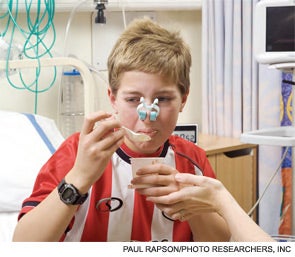BOSTON—New ways of diagnosing food allergies are on the horizon, with allergy experts hoping that it might be possible one day for many patients to avoid the traditional food challenge test (FCT).
Explore This Issue
October 2010A recently published Italian study, discussed at the 2010 Annual Meeting of the American Academy of Otolaryngology-Head and Neck Surgery, held here Sept. 26-29, found that examining the levels of certain proteins could help with allergy diagnosis (D’Urbano LE, Pellegrino K, Artesani MC, et al. Clin Exp Allergy. 2010;40(10):1561-1570). Researchers found that when the traditional blood test for cow’s milk and hen’s egg allergy is combined with a new diagnostic blood test called component resolved diagnosis (CRD), the diagnostic accuracy approaches that of the traditional double-blind, placebo-controlled, food challenge test.

“Is there a way to avoid what’s always been the gold standard for food allergies, which is double-blind, placebo-controlled food challenge, which is time-consuming, expensive and can be somewhat dangerous?” said Karen Calhoun, MD, professor of otolaryngology-head and neck surgery at The Ohio State University College of Medicine in Columbus, who discussed the study in her presentation.
In the study, the researchers reported that the “ideal” in vitro test should allow patients and their doctors to avoid the FCT. The study included 104 children, some with allergies to milk and others with allergies to eggs.
Researchers found that the ImmunoCAP (ICAP) test, a blood test commonly used to detect allergies, was 93 percent predictive of a positive food allergy test result when a threshold of at least 16.6 kU/L was met for cow’s milk immunoglobulin E (IgE). But when that level was below 16.6 kU/L, the test was only 43 percent predictive.
Researchers divided this second group based on their levels of the allergen Bos d 8 and found that 14 out of 15 patients with levels above 0.6 ISAC standardized units (ISU) had also been positive in food challenge tests.
Looking at specific allergens may be a way to attain more accuracy than would be possible with the ICAP test alone—without having to do a food challenge test, Dr. Calhoun said. “This is honing in on something that is clinically useful,” she said.
That microarray-based test might make the process more tolerable to children, said Maria Veling, MD, associate professor of surgery in the division of otolaryngology-head and neck surgery at the University of Kentucky in Lexington. “The big advantage of that test is that it requires less blood to be performed,” she said. “And this is very helpful when you’re trying to test children.”
Other Options
This and other advances come as food allergies continue to rise. According to Dr. Calhoun, 2 to 3 percent of adults and 6 to 8 percent of infants have food allergies, including 35 percent of children with moderate to severe atopic dermatitis. In addition, 45 percent of young children have asthma. The presenters pointed out, however, that about 25 percent of adults think they have a food allergy.
Leave a Reply